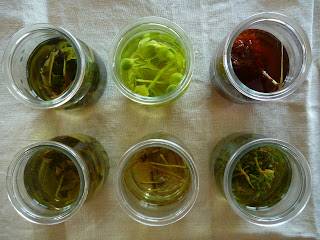Today I had another chance to go on a hike with the baby. We went to collect lichens but that soon evolved into other things. I decided to pick some flora for samples. We even found an old birds nest.
 |
| Dye tests in old yogurt cups. |
When we got home I tore my samples into pieces, put them into old yogurt cups and poured boiling water over them. There were two real stand outs.
 |
| Left, wild hellebore test. Right, hairy rose hip test. |
The wild hellebore flowers and the deformed rose hips made some surprising color. The flowers made a clear lime green tint.
 |
| Hellebore flower test. |
The deformed hairy rose hips were full of color, a beautiful rusty orange. I've very eager to collect more for a proper dye bath. I know that rose hips can be used for dyeing, but it's a pain to collect them and I'd rather use them for tea or jam. These weird deformed rose hips are on almost all of the roses in my fields. I think there are usually about three or four per plant. I'm not sure if the winter sun has roasted them, but I think that may be a factor.
 |
| Deformed rose hip. |
 |
| Deformed rose hip test. |
The everlasting was a pretty predictable yellow green. The stems from the same plant were only slightly more to the yellow end. I don't think you can see the difference in the pictures. I'm going the try the flowers out later this summer.
 |
| Everlasting leaves test jar. |
 |
| Everlasting stems test jar. |
The wild hellebore leaves were also a nice warm peachy green color. Note: hellebore are poisonous plants. Don't leave the dye bath where animals or kids can reach it. Wash the fibers well after dyeing.
 |
| Wild hellebore leaves test jar. |
There's an oak by the barn that I've been wanting to test for awhile. It's a strange sort of oak tree. It makes acorns, but doesn't lose its leaves in the winter. I'll have to go and look up the name of it. It did make a nice peachy bath. Tomorrow I'll stick some yarn samples in each jar and heat them up in a little pan of water.
I've also been mordanting as much as possible in preparation for spring.
Because of the nice weather I've been out in the garden a lot. I trimmed 650g of branches and leaves off of my sage bush and decided to make a bath out of them before I chucked them into the compost pile. I chopped and simmered the leaves in tap water before straining the bath. I dyed 200g wool. What an amazing surprise. The bath didn't look like much, but it made a very vibrant yellow green.
Maybe it's because I've been suffering from a cold but the sage bath also inspired me to make a juniper bath. I used 450g of chopped up juniper branches to 200g wool, simmered for a little over an hour. The final color was less inspiring, but still pretty. It's a slightly orange gold color.
This yarn I'm dyeing is a 2 ply Blue Faced Leicester. It's supposed to be a sock yarn, but I'm not sure that it's cushy enough. I'll have to test it out. It took a lot of washing to get the spinning oil and natural oils out. I'm very glad to have taken to time to wash the fibers before dyeing them. I'm pretty sure my last dyeing disaster was due to my not taking the time to wash the fibers first. Lesson learned.












I think your misformed rose hips are galls, not rose hips at all. That migth be why the do not dye the expected colour.
RépondreSupprimerDo they look like this: http://fr.wikipedia.org/wiki/Fichier:Galle1.jpg
I think you're right about them being galls. They look like the work of an insect rather than a virus. Thanks for commenting.
RépondreSupprimer